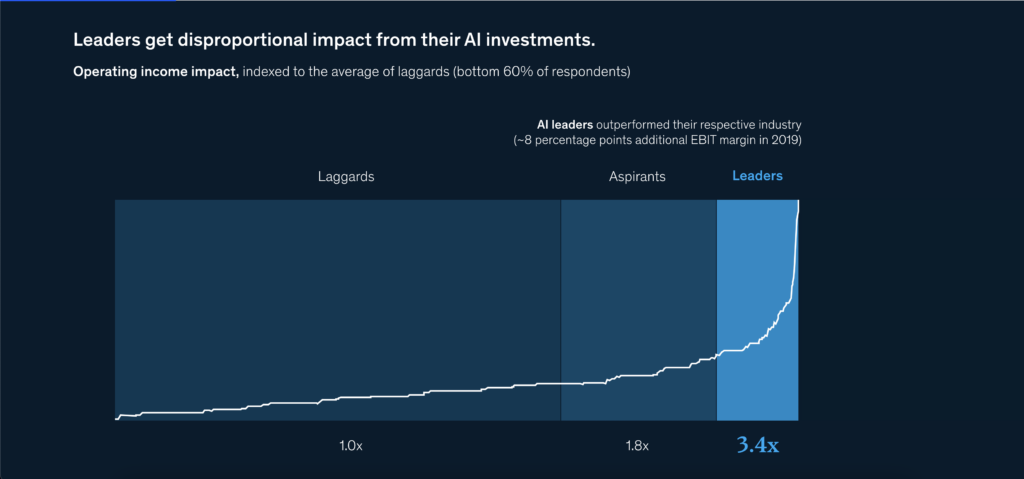Dr. Tim Fountaine, Senior Partner at McKinsey & Company joins us at H2O World Sydney 2022 to discuss why business leaders should care about AI, what mindset to adopt, and what actions to take to effectively bring AI into your organization. Dr. Fountaine discusses real-world examples and insights from McKinsey’s collaboration with the Stanford Institute for Human-Centered Artificial Intelligence to show how the best companies in the world are delivering impact from this exciting technology.
America’s Cup
The America’s Cup is the oldest sporting event in the world. Technology’s changed a lot since the 1800s when it was first sailed. The yachts now don’t go through the water. They more fly above it on a hydrofoil. These types of yachts, it’s an AC 75, can go at about a hundred kilometers an hour. And it exists right on the edge between the forces of the wind and the hydrodynamic forces of the water. They’re incredible yachts, but it doesn’t really change the old adage in the America’s Cup that the fastest boat usually wins the race.
Now, at the last America’s Cup, team New Zealand realized that their ability to win was going to be proportional to how many boats they could essentially design and test. But there are quite a lot of restrictions. They didn’t have a lot of time. They had one of the smallest budgets of any of the teams and the rules actually prohibit you making too many physical yachts. So they created a simulator and did a lot of their boat design in silicon instead of on the water. But even testing a simulation is very difficult. It requires the sailors to come off the water and actually sail on the computer. They never do it quite the same way each time. So it can be hard to tell if it’s the boat design or the sailors sailing differently. And of course you can only do one at a time.
Creating an AI sailor
So they came to us with a question. Could we create an AI sailor to sail their yacht? And I must admit, when I first looked at this, I thought it was crazy. These yachts have 11 people on them. They have 14 different inputs, the rudder, the sheets, trims, even the angle of the foils. So it’s a very complicated problem. We decided to give it a go. It was our big R&D project for last year. And we decided to break the problem down into little steps.
First thing was, could we even get the boat to sail in a straight line? Well, just like a baby learning to walk, our first attempts were terrible, it would capsize, they wouldn’t get out of the water. But eventually the system learned and it started to sail. And then over time, we could add things, we could get it to tack and we could get it to gybe, and we get it to go around the course. And before long, well, it was a few months, it started to compete with Olympic sailors and give them a run for their money.
Effects of the AI sailor
Now, the effect of this was really significant in the sense that it allowed the team to test a lot more boat designs. It allowed them to do runs overnight, do them in parallel. We think they ended up testing about 10 times as many boat designs as they could have otherwise. And it reduced the cost of testing by about 95%. And most importantly, team New Zealand won the cup last year. Now it’s not just sports teams that are doing amazing things with AI, of course.
Stanford’s annual AI report
Each year we team up with Stanford University to help them write their AI annual report. And over the years we’ve been doing that, it’s amazing the size of the change that’s happened. So there’s now over half of companies, when we survey them, say they’re using AI in some meaningful way in their businesses.
The cost of training or the time to train a model has roughly halved. It’s now 95% faster. There’s 30 times as many patents published last year as in 2018, 2015. And there’s a huge amount of investment going into the field. So there’s a lot of excitement.
And sports teams like Team New Zealand are doing some incredible things. But there is a reality. And the reality is that most organizations aren’t getting the impact they would want. One of the figures that really staggered me was only 11% of use cases ever end up in production. A lot of CEOs or executives talk to me about this. They call it their pilot purgatory. They’re just stuck doing little pilots of things, but really struggle to get it to scale. So the question is what do companies do to get past this? What are the 11% doing?
Some companies are getting it right
And so we’ve been researching this over the last few years. And one of the things that we’ve found is while most companies are really struggling, and this just shows a selection of about 800 companies just ranked from those with the most AI maturity on the right down to the ones with the least on the left and their relative EBIT compared to peers in the same industry.
And you can see that while most companies are really struggling to get impact, the ones that are doing well on AI are outperforming the others. They get about three and a half times as much EBIT relative to their peers. And when we ask them, what do you do? What are you doing differently to the other companies? There are a number of elements that seem to be important.
The leaders consider six core elements
The first one is having the right plan or the right strategy. We’re finding that they’re focusing on a few places and doing it really, really well. Rather than spreading themselves too thin, they then concentrate on four capabilities–talent, ways of working, technology, and data–that seem to be areas that really distinguish the best. And then last of all, there’s adoption and culture. We know that the companies that are doing the best spend about half of their budgets for technology on change and adoption, so on training, process redesign, and the softer side of it, not just the tech.
- Roadmap
- Talent
- Ways of working
- Technology & tooling
- Data
- Adoption and culture
So for the rest of my talk, I’m just going to go through these and talk about some of the insights we’ve had spending time with these companies, talk about how this works with Team New Zealand, just to help explain it. And then at the end we’ll come to questions and we can have a chat about what you see in your organizations or what’s working for you.
1. Roadmap: Leaders are investing >15% of IT spend in AI
So let’s start with the plan and strategy. The first thing we found was that the very best companies are spending something like 15% of their IT budgets on AI. So they’re actually investing purposefully at a scale. That means that they can do something meaningful, but it’s not just the amount they’re investing; it’s also how they’re focusing it. A lot of the companies in that laggards group on the left, we find that they’re often doing a lot of different use cases, but very often spread out across the organization. It’s almost like they go around each part of the business and say, what can I do with AI? What can I do with data and analytics? And they’ve got all these different things going, but none of them ever reach scale. So what we’re finding is that the companies doing this better tend to say there are two or three, I could call them domains, but areas, steps in my value chain that create a lot of value or could create a lot of value and they focus there. So for a mining company, it might be predictive maintenance or simulating a mine. For a bank, it might be personalization. And then they just focus there and direct all of their efforts into doing well in a couple of places.
2. Talent: Leaders are investing more
On talent, the first of the four capabilities I mentioned, one of the things we find is the best companies are investing a lot more and they’re doing it across the board. Now, there is something about engineering where they’re investing even more than others. AI engineering, cloud engineering, but it’s actually across the board and they’re investing one and a half to two times the other companies. So obviously that’s important, but it’s not just about getting tech talent. What we’re also finding is the best companies are trying to re-skill their organizations. And one really telling set of facts on this is that the companies that are doing best tend to have a large number of leaders who understand technology.
So whether you measure it from an economics performance point of view, more of those companies have half a dozen or more technically savvy leaders in their executive team. Or if you just measure it from the point of view of the ones with the best capabilities, again, we see the same thing. This is this really strong relationship between companies with leaders who understand technology and doing well at this stuff. Now, it’s not surprising perhaps, but it’s no longer enough just to have a great chief digital officer or chief technology officer it seems when you look at the data coming back.
3. Ways of working
In terms of ways of working, the biggest idea is probably agile. The idea of cross-functional teams focused on solving problems quickly. But when we break it down, and this was from some research we’ve been doing on developer velocity, and the reason we did the research was because we get so many CEOs coming to us and saying, I am spending so much money on engineering talent. I’ve hired the best people, I’ve got thousands of people capable of developing digital and AI solutions, but it’s just so slow, I’m not getting much back.
So we’ve been researching what is it that differentiates the companies that work faster. And there seem to be four sets of capabilities that really distinguish the best. One set is around tools. So that’s everything from collaboration tools, but also tools that allow them to develop faster, manage DevSecOps professionally, product management, having great product managers. Some organizations call them product owners, but that seems to be one skill set, which is perhaps underdone in many companies. But for those who have really got the best, it makes a huge difference. Then there’s culture, adaptability, willingness to experiment, cross-functional, that kind of culture that I think many of us would recognize as being the type of culture that’s great at software development. And then finally all of the different disciplines of talent management. You can see that the companies doing best are better at that. So those seem to be the things that give you velocity when it comes to ways of working.
4. Technology & 5. Data
And then when it comes to technology and data, I mean we could talk about this for ages, but I’ll just, some of the things that come out really clearly when you look at the practices of the best companies, obviously adoption of public cloud, I think there’s now enough evidence to say that that is important. They’ve got clear data strategies and actually another proxy for that would be just measuring how often can they reuse data. If you were to start an AI project in your organization, would you have all the data that you need or would you have to go build that before you can do anything? Because that’s guaranteed to slow everything down by months. They have good DevSecOps practices, they use design thinking, so they start from customer back, whether that be an external customer or an internal customer. And they’ve got automated processes for testing and deploying technology. So we’re starting to build up a good understanding of the things that really matter and where investments should go.
6. Adoption & Culture
But all of this is useless without culture and adoption. And I see so many companies that I work with and actually have experienced myself when we make what I think is great software and just see it fall into the heap of proof of concepts that never scale.
I wrote this article with a couple of colleagues a few years ago: Building the AI-Powered Organization. I’ve written different articles over time on more technical things and data and so on, but this was the one that seemed to resonate the best. It ended up on the cover of this magazine and it receives a lot of attention because I think it resonates with a lot of people.
The technology’s often not the problem. It’s often more the ways that people work together, the attitude of leaders towards these new technologies and our ability to actually get them to be adopted within a process or a component of a company.
Recap
So just to recap, I said that there were six really important things that we are finding are the differences between the best companies and the laggards as I’ve called them. One’s having a great roadmap that focuses you on a few really important areas and provides enough investment to do this at scale. Then there are these four capabilities: talent, ways of working, tech, and data. But then of course all of that is useless without the right adoption. And before I turn to questions, just one more parting thought. The last couple of years have been pretty tricky and there’s a high possibility that next year might be, too. But I really love this quote from Ayrton Senna: “You can’t overtake 15 cars and sunny weather, but you can when it’s raining.” So to me, there’s never been a better time to invest in this stuff. We may well need it in the next few years.











